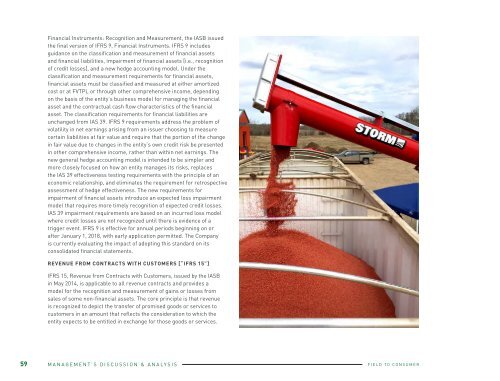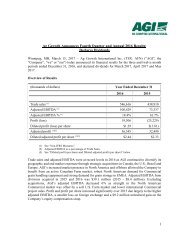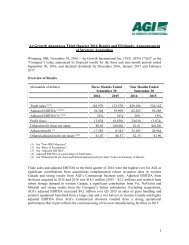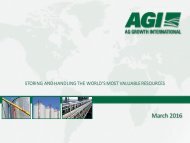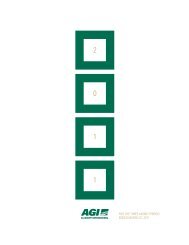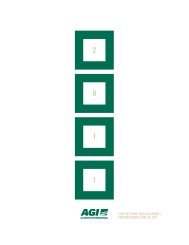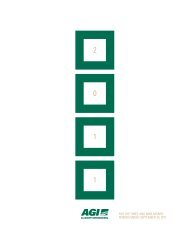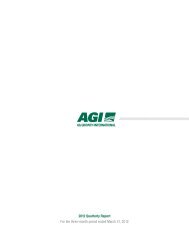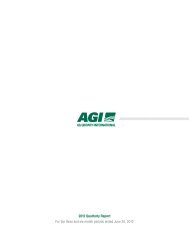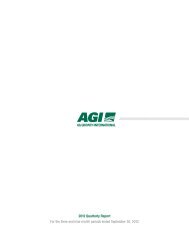2016 Annual Report For Web 7.3MB
Create successful ePaper yourself
Turn your PDF publications into a flip-book with our unique Google optimized e-Paper software.
Financial Instruments: Recognition and Measurement, the IASB issued<br />
the final version of IFRS 9, Financial Instruments. IFRS 9 includes<br />
guidance on the classification and measurement of financial assets<br />
and financial liabilities, impairment of financial assets [i.e., recognition<br />
of credit losses], and a new hedge accounting model. Under the<br />
classification and measurement requirements for financial assets,<br />
financial assets must be classified and measured at either amortized<br />
cost or at FVTPL or through other comprehensive income, depending<br />
on the basis of the entity’s business model for managing the financial<br />
asset and the contractual cash flow characteristics of the financial<br />
asset. The classification requirements for financial liabilities are<br />
unchanged from IAS 39. IFRS 9 requirements address the problem of<br />
volatility in net earnings arising from an issuer choosing to measure<br />
certain liabilities at fair value and require that the portion of the change<br />
in fair value due to changes in the entity’s own credit risk be presented<br />
in other comprehensive income, rather than within net earnings. The<br />
new general hedge accounting model is intended to be simpler and<br />
more closely focused on how an entity manages its risks, replaces<br />
the IAS 39 effectiveness testing requirements with the principle of an<br />
economic relationship, and eliminates the requirement for retrospective<br />
assessment of hedge effectiveness. The new requirements for<br />
impairment of financial assets introduce an expected loss impairment<br />
model that requires more timely recognition of expected credit losses.<br />
IAS 39 impairment requirements are based on an incurred loss model<br />
where credit losses are not recognized until there is evidence of a<br />
trigger event. IFRS 9 is effective for annual periods beginning on or<br />
after January 1, 2018, with early application permitted. The Company<br />
is currently evaluating the impact of adopting this standard on its<br />
consolidated financial statements.<br />
REVENUE FROM CONTRACTS WITH CUSTOMERS [“IFRS 15”]<br />
IFRS 15, Revenue from Contracts with Customers, issued by the IASB<br />
in May 2014, is applicable to all revenue contracts and provides a<br />
model for the recognition and measurement of gains or losses from<br />
sales of some non-financial assets. The core principle is that revenue<br />
is recognized to depict the transfer of promised goods or services to<br />
customers in an amount that reflects the consideration to which the<br />
entity expects to be entitled in exchange for those goods or services.<br />
The standard will also result in enhanced disclosures about<br />
revenue, provide guidance for transactions that were not previously<br />
addressed comprehensively [for example, service revenue and<br />
contract modifications] and improve guidance for multiple-element<br />
arrangements. IFRS 15 is effective for annual periods beginning on<br />
or after January 1, 2018, and is to be applied retrospectively, with<br />
earlier adoption permitted. Entities will transition following either a<br />
full or modified retrospective approach. The Company is currently<br />
evaluating the impact of the above standard on its consolidated financial<br />
statements.<br />
LEASES [“IFRS 16”]<br />
In January <strong>2016</strong>, the IASB released IFRS 16, Leases, to replace the<br />
previous leases Standard, IAS 17, Leases, and related Interpretations.<br />
IFRS 16 sets out the principles for the recognition, measurement,<br />
presentation and disclosure of leases for both parties to a contract,<br />
the customer [lessee] and the supplier [lessor]. IFRS 16 eliminates the<br />
classification of leases as either operating leases or finance leases and<br />
introduces a single lessee accounting model. IFRS 16 also substantially<br />
carries forward the lessor accounting requirements. Accordingly, a<br />
lessor continues to classify its leases as operating lease or finance<br />
leases, and to account for those two types of leases differently.<br />
IFRS 16 will be effective for the Company’s fiscal year beginning on<br />
January 1, 2019, with earlier application permitted only if the Company<br />
applies IFRS 15. The Company has not yet assessed the impact of the<br />
adoption of this standard on its consolidated financial statements.<br />
SHARE-BASED PAYMENT [“IFRS 2”]<br />
In June <strong>2016</strong>, the IASB issued amendments to IFRS 2, Share-based<br />
Payment, clarifying how to account for certain types of share-based<br />
payment transactions. The amendments provide requirements on the<br />
accounting for the effects of vesting and non-vesting conditions on the<br />
measurement of cash-settled share-based payments, share-based<br />
payment transactions with a net settlement feature for withholding tax<br />
obligations and a modification to the terms and conditions of a sharebased<br />
payment that changes the classification of the transaction from<br />
cash-settled to equity-settled. The amendments apply for annual<br />
periods beginning on or after January 1, 2018. The Company is currently<br />
evaluating the impact of the amendments to IFRS 2 on its consolidated<br />
financial statements.<br />
DISCLOSURE CONTROLS AND PROCEDURES<br />
AND INTERNAL CONTROLS<br />
Disclosure controls and procedures are designed to provide reasonable<br />
assurance that all relevant information is gathered and reported to<br />
senior management, including AGI’s Chief Executive Officer and Chief<br />
Financial Officer, on a timely basis so that appropriate decisions can be<br />
made regarding public disclosure.<br />
Management of AGI is responsible for designing internal controls<br />
over financial reporting for the Company as defined under National<br />
Instrument 52-109 issued by the Canadian Securities Administrators.<br />
Management has designed such internal controls over financial<br />
reporting, or caused them to be designed under their supervision, to<br />
provide reasonable assurance regarding the reliability of financial<br />
reporting and the preparation of the financial statements for external<br />
purposes in accordance with IFRS.<br />
In <strong>2016</strong> AGI acquired Entringer, NuVision, Mitchell and Yargus. See<br />
“Acquisitions”. Management has not completed its review of internal<br />
controls over financial reporting or disclosure controls and procedures<br />
for these newly acquired operations. Since the acquisition occurred<br />
within 365 days of the end of the reporting period, management has<br />
limited the scope of design, and subsequent evaluation, of disclosure<br />
controls and procedures and internal controls over financial reporting<br />
to exclude controls, policies and procedures of this acquisition,<br />
as permitted under Section 3.3 of National Instrument 52-109 -<br />
Certification of Disclosure in Issuer’s <strong>Annual</strong> and Interim Filings.<br />
<strong>For</strong> the period covered by this MD&A, management has undertaken<br />
specific procedures to satisfy itself with respect to the accuracy and<br />
completeness of the financial information of Entringer, NuVision,<br />
Mitchell and Yargus. The following is the summary financial information<br />
pertaining to VIS, Entringer, NuVision and Mitchell that were included in<br />
AGI’s consolidated financial statements for the year December 31, <strong>2016</strong>:<br />
59 MANAGEMENT’S DISCUSSION & ANALYSIS<br />
FIELD TO CONSUMER<br />
<strong>2016</strong> ANNUAL REPORT<br />
MANAGEMENT’S DISCUSSION & ANALYSIS 60


